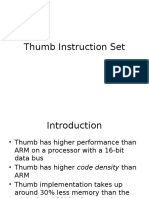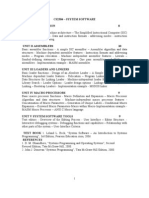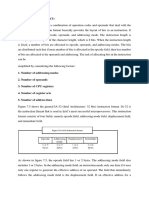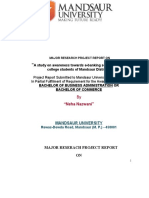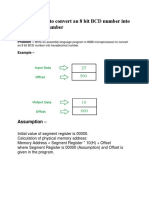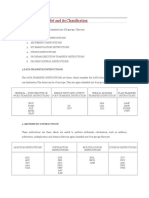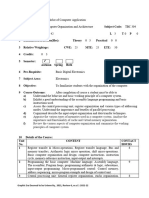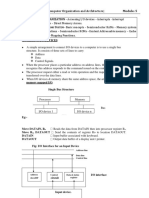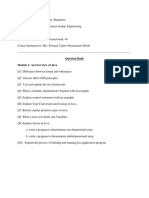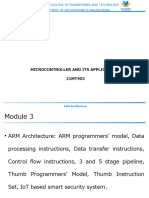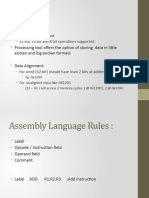Embedded System Design Center
ARM7TDMI Microprocessor
Data Processing I nstructions
Sai Kumar Devulapalli
2 of 35
Objectives
Detailed understanding of ARM Data processing instructions
Understanding the instruction encoding formats
Understanding the general format with which data processing
instructions can be conditionally executed and to set the status
flags
Use of immediate operand in the data processing operations
Understand the use of shifter operations for second operand
Understand the operation of multiplication instructions
3 of 35
Data processing Instructions
Largest family of ARM instructions, all sharing the same
instruction format.
Contains:
Arithmetic operations
Comparisons (no results - just set condition codes)
Logical operations
Data movement between registers
Remember, this is a load / store architecture
These instruction only work on registers, NOT memory.
They each perform a specific operation on one or two
operands.
First operand always a register - Rn
Second operand sent to the ALU via barrel shifter.
We will examine the barrel shifter shortly.
4 of 35
Arithmetic AND logical Instructions: General Format
Opcode{Cond}{S} Rd,Rn,Operand 2
{Cond} - Conditional Execution of instruction
E.g. GT=GREATER THAN,LT = LESS THAN
{S} - Set the bits in status register after execution.
{Operand 2}- various form of the instruction
immediate/register/shifting
you can easily check all the combinations in the quick
references of ARM.
5 of 35
Instruction format
31 28 27 26 25 24 21 20 19 16 15 12 11 0
Cond 0 0 # opcode S Rn Rd operand 2
Opcode: Arithmetic / Logic Function
S : Set condition code
Rn : First operand (ARM Register)
Rd : Destination operand (ARM Register)
6 of 35
32 bit immediate
If # (I) = 1 then operand 2 field will be
#rot 8-bit immediate
11 8 7 0
The actual immediate value is formed by rotating right the 8-
bit immediate value by the even positions (#rot * 2) in a 32
bit word.
If #rot = 0 (when immediate value is less than 0xFF 8 bit)
then carry out from the shifter will be indicated in C flag.
Because of this all 32 bit immediate are not legitimate. Only
those which can be formed.
7 of 35
Register operand
# (I) = 0 indicates that the second operand is specified in register
which can also be shifted.
#shift Sh 0 Rm
11 7 6 5 4 3 0
# Shift : Immediate shift length
Rs : Register shift length
Sh : Shift type
Rm : Register used to hold second operand.
Rs 0 Sh 1 Rm
11 8 7 6 5 4 3 0
Ex:
ADD RO, R1, R2, LSL #3
Ex:
ADD RO, R1, R2, LSL R3
8 of 35
Shift operations
Guided by Sh field in the format
Sh = 00 Logical Shift Left : LSL Operation
Sh = 01 Logical Shift Right : LSR Operation
Sh = 10 Arithmetic Shift Right : ASR Operation
Sh = 11 Rotate Right : ROR Operation
With Sh = 11 and #shift = 00000 (similar to ROR #0) is used
for RRX operation.
9 of 35
Immediate value
8 bit number
Can be rotated right through
an even number of
positions.
Assembler will calculate
rotate for you from
constant.
Register, optionally with shift
operation applied.
Shift value can be either be:
5 bit unsigned integer
Specified in bottom byte
of another register.
Operand
1
Result
ALU
Barrel
Shifter
Operand
2
Using the Barrel Shifter: The Second Operand
10 of 35
Data Processing instructions
0000 AND
0001 EOR
0010 SUB
0011 RSB
0100 ADD
0101 ADC
0110 SBC
0111 RSC
1000 TST
1001 TEQ
1010 CMP
1011 CMN
1100 ORR
1101 MOV
1110 BIC
1111 MVN
11 of 35
Arithmetic Operations
Operations are:
ADD operand1 + operand2
ADC operand1 + operand2 + carry
SUB operand1 - operand2
SBC operand1 - operand2 + carry -1 <Sub. with C>
RSB operand2 - operand1 <Reverse Sub>
RSC operand2 - operand1 + carry 1 <Rev.Sub.with C>
Syntax:
<Operation>{<cond>}{S} Rd, Rn, Operand2
Examples
ADD r0, r1, r2
SUBGT r3, r3, #1
RSBLES r4, r5, #5
12 of 35
Logical Operations
Operations are:
AND operand1 AND operand2
EOR operand1 EOR operand2
ORR operand1 OR operand2
BIC operand1 AND NOT operand2 [ie bit clear]
Syntax:
<Operation>{<cond>}{S} Rd, Rn, Operand2
Examples:
AND r0, r1, r2
BICEQ r2, r3, #7
EORS r1, r3, r0
13 of 35
Comparisons
The only effect of the comparisons is to
UPDATE THE CONDITION FLAGS. Thus no need to set
S bit.
Operations are:
CMP operand1 - operand2, but result not written
CMN operand1 + operand2, but result not written
TST operand1 AND operand2, but result not written
TEQ operand1 EOR operand2, but result not written
Syntax:
<Operation>{<cond>} Rn, Operand2
14 of 35
Comparisons
Examples:
CMP r0, r1
CMP R1,Operand2 e.g. CMP R1,R2
[R1] - [R2]
Set the N Z C V in CPSR register.
TSTEQ r2, #5
TST R1, Operand2 e.g. TST R1,R2
[R1] AND [R2]
15 of 35
Data Movement
Operations are:
MOV Rd, operand2
MVN Rd, (NOT) operand2
Note that these make no use of operand1.
Syntax:
<Operation>{<cond>}{S} Rd, Operand2
Examples:
MOV r0, r1
MVN r0, r1
MOVS r2, #10
MVNEQ r1, #0
16 of 35
Quiz
Start
Stop
r0 = r1
?
r0 > r1
?
r0 = r0 - r1 r1 = r1 - r0
Yes
No Yes
No
* Convert the GCD algorithm
given in this flowchart into
1) Normal assembler,
where only branches can be
conditional.
2) ARM assembler, where all
instructions are conditional,
thus improving code
density.
* The only instructions you
need are CMP, B and SUB.
17 of 35
Quiz - Sample Solutions
Normal Assembler
gcd cmp r0, r1 ;reached the end?
beq stop
blt less ;if r0 > r1
sub r0, r0, r1 ;subtract r1 from r0
bal gcd
less sub r1, r1, r0 ;subtract r0 from r1
bal gcd
stop
ARM Conditional Assembler
gcd cmp r0, r1 ;if r0 > r1
subgt r0, r0, r1 ;subtract r1 from r0
sublt r1, r1, r0 ;else subtract r0 from r1
bne gcd ;reached the end?
18 of 35
The Barrel Shifter
The ARM doesnt have actual shift instructions.
Instead it has a barrel shifter which provides a mechanism to
carry out shifts as part of other instructions.
So what operations does the barrel shifter support?
19 of 35
Shifts left by the specified amount (multiplies by powers of
two) e.g.
LSL #5 = multiply by 32
Barrel Shifter - Left Shift
Logical Shift Left (LSL)
Destination CF
0
20 of 35
Logical Shift Right
Shifts right by the
specified amount (divides
by powers of two) e.g.
LSR #5 = divide by 32
Arithmetic Shift Right
Shifts right (divides by
powers of two) and
preserves the sign bit, for
2's complement
operations. e.g.
ASR #5 = divide by 32
Barrel Shifter - Right Shifts
Destination CF
Destination CF
Logical Shift Right
Arithmetic Shift Right
...0
Sign bit shifted in
21 of 35
Barrel Shifter - Rotations
Rotate Right (ROR)
Similar to an ASR but the bits
wrap around as they leave the
LSB and appear as the MSB.
e.g. ROR #5
Note the last bit rotated is also
used as the Carry Out.
Rotate Right Extended (RRX)
This operation uses the CPSR C
flag as a 33rd bit.
Rotates right by 1 bit. Encoded
as ROR #0.
Destination CF
Rotate Right
Destination CF
Rotate Right through Carry
22 of 35
Second Operand: Shifted Register
The amount by which the register is to be shifted is
contained in either:
the immediate 5-bit field in the instruction
NO OVERHEAD
Shift is done for free - executes in single cycle.
the bottom byte of a register (not PC)
Then takes extra cycle to execute
ARM doesnt have enough read ports to read 3 registers
at once.
Then same as on other processors where shift is
separate instruction.
If no shift is specified then a default shift is applied: LSL #0
i.e. barrel shifter has no effect on value in register.
23 of 35
Using a multiplication instruction to multiply by a constant
means first loading the constant into a register and then waiting
a number of internal cycles for the instruction to complete.
A more optimum solution can often be found by using some
combination of MOVs, ADDs, SUBs and RSBs with shifts.
Multiplications by a constant equal to a ((power of 2) 1)
can be done in one cycle.
Example: r0 = r1 * 5
Example: r0 = r1 + (r1 * 4)
ADD r0, r1, r1, LSL #2
Example: r2 = r3 * 105
Example: r2 = r3 * 15 * 7
Example: r2 = r3 * (16 - 1) * (8 - 1)
RSB r2, r3, r3, LSL #4 ; r2 = r3 * 15
RSB r2, r2, r2, LSL #3 ; r2 = r2 * 7
Second Operand:Using a Shifted Register
24 of 35
Loading full 32 bit constants
Although the MOV/MVN mechanism will load a large range of
constants into a register, sometimes this mechanism will not
generate the required constant.
Therefore, the assembler also provides a method which will load
ANY 32 bit constant:
LDR rd,=numeric constant
If the constant can be constructed using either a MOV or MVN then
this will be the instruction actually generated.
Otherwise, the assembler will produce an LDR instruction with a
PC-relative address to read the constant from a literal pool.
LDR r0,=0x42 ; generates MOV r0,#0x42
LDR r0,=0x55555555 ; generate
LDR r0,[pc, offset to lit pool]
As this mechanism will always generate the best instruction for a
given case, it is the recommended way of loading constants.
25 of 35
Multiplication Instructions
The Basic ARM provides two multiplication instructions.
Multiply
MUL{<cond>}{S} Rd, Rm, Rs ; Rd = Rm * Rs
Multiply Accumulate - does addition for free
MLA{<cond>}{S} Rd, Rm, Rs, Rn ; Rd = (Rm * Rs) + Rn
Restrictions on use:
Rd and Rm cannot be the same register
Can be avoid by swapping Rm and Rs around. This works because
multiplication is commutative.
Cannot use PC.
These will be picked up by the assembler if overlooked.
Operands can be considered signed or unsigned
Up to user to interpret correctly.
26 of 35
Instructions are
MULL which gives RdHi,RdLo:=Rm*Rs
MLAL which gives RdHi,RdLo:=(Rm*Rs)+RdHi,RdLo
However the full 64 bit of the result now matter (lower
precision multiply instructions simply throws top 32bits
away)
Need to specify whether operands are signed or unsigned
Warning : Unpredictable on non-M ARMs.
Syntax:
UMULL/UMLAL{cond} {S} RdLo, RdHi, Rm, Rs
SMULL/SMLAL{cond} {S} RdLo, RdHi, Rm, Rs
Multiply-Long and Multiply_Accumulate Long
27 of 35
Instruction Format
000 MUL Rd := (Rm * Rs)
001 MLA Rd := (Rm * Rs) + Rn
100 UMULL RdHi : RdLo := Rm * Rs
101 UMLAL RdHi : RdLo += Rm * Rs
110 SMULL RdHi : RdLo := Rm * Rs
111 SMLAL RdHi : RdLo += Rm * Rs
31 28 27 24 23 21 20 19 16 15 12 11 8 7 4 3 0
Cond 0 0 0 0 mul S Rd/RdHi Rn/RdLo Rs 1 0 0 1 Rm
28 of 35
Example: C assignments
C:
x = (a + b) - c;
Assembler:
ADR r4,a ; get address for a
LDR r0,[r4] ; get value of a
ADR r4,b ; get address for b, reusing r4
LDR r1,[r4] ; get value of b
ADD r3,r0,r1 ; compute a+b
ADR r4,c ; get address for c
LDR r2[r4] ; get value of c
SUB r3,r3,r2 ; complete computation of x
ADR r4,x ; get address for x
STR r3[r4] ; store value of x
29 of 35
Example: C assignment
C:
y = a*(b+c);
Assembler:
ADR r4,b ; get address for b
LDR r0,[r4] ; get value of b
ADR r4,c ; get address for c
LDR r1,[r4] ; get value of c
ADD r2,r0,r1 ; compute partial result
ADR r4,a ; get address for a
LDR r0,[r4] ; get value of a
MUL r2,r2,r0 ; compute final value for y
ADR r4,y ; get address for y
STR r2,[r4] ; store y
30 of 35
Example: C assignment
C:
z = (a << 2) | (b & 15);
Assembler:
ADR r4,a ; get address for a
LDR r0,[r4] ; get value of a
MOV r0,r0,LSL 2 ; perform shift
ADR r4,b ; get address for b
LDR r1,[r4] ; get value of b
AND r1,r1,#15 ; perform AND
ORR r1,r0,r1 ; perform OR
ADR r4,z ; get address for z
STR r1,[r4] ; store value for z
31 of 35
Example: FIR filter
C:
for (i=0, f=0; i<N; i++)
f = f + c[i]*x[i];
Assembler
; loop initiation code
MOV r0,#0 ; use r0 for I
MOV r8,#0 ; use separate index for arrays
ADR r2,N ; get address for N
LDR r1,[r2] ; get value of N
MOV r2,#0 ; use r2 for f
32 of 35
FIR filter, cont.d
ADR r3,c ; load r3 with base of c
ADR r5,x ; load r5 with base of x
; loop body
loop LDR r4,[r3,r8] ; get c[i]
LDR r6,[r5,r8] ; get x[i]
MUL r4,r4,r6 ; compute c[i]*x[i]
ADD r2,r2,r4 ; add into running sum
ADD r8,r8,#4 ; add 1 word offset to array index
ADD r0,r0,#1 ; add 1 to i
CMP r0,r1 ; exit?
BLT loop ; if i < N, continue
33 of 35
Barrel Shifter executing Fixed Point Arithmetic
34 of 35
Summary
All data processing operations work only on internal registers,
immediate operands and NOT on memory.
Data processing instructions
Arithmetic ADD, ADC, SUB, SBC, RSB, RSC
Comparison CMP, CMN, TST, TEQ
Logical ORR, AND, EOR, BIC
Data Movement MOV, MVN
Shifter Operations LSL, LSR, ASR, ROR, RRX
Multiplication Instructions MUL, MLA, MULL, MLAL
35 of 35
Thank You, Any Questions ?






